Mastering KCSE Biology with Comprehensive Topical Questions and Answers
(a) Identify the function of the part labeled Q (1mk)
Offers a large surface area for muscle attachment
(b) Name the bone that circulates with the bone above at the proximal end (1mk)
Humerus;
Rej: Humerous or other wrong spellings for humerus (c) List down two types of support tissue in plants (2mks)
0 Comments
1. 1989 Q6 P1
The diagram below represents a mammalian bone
(a) State the functions labelled K and L
(b) State the region of the body in which the bone is found 2. 1991 Q1 P1 State two ways in which skeletal muscle fibers are adapted to their functions 3. 1991 Q5 P1 The diagram below shows the arrangement of bones and muscles in a human arm K.C.S.E Biology Q & A - MODEL 2019PP1QN25
State one characteristic of muscles responsible for each of the following:
(a) peristaltic movement (b) movement of limbs
answers
(a) spindle shape
Lack striations/ not striated Uninucleated /one nucleus (b) striated; Numerous mitochondrion; Multinucleated/many nucleus Cylindrical shaped. K.C.S.E Biology Q & A - MODEL 2018PP2QN04
The diagram below illustrates the arrangement of bones in a human arm.
(a) Name:
(i) the type of joints formed at points H and M. H M (ii) bone G (b) Name bone J and state how it is adapted to its functions. Name Adaptation (c) State one functional difference between a tendon and a ligament.
answers
a) i. H-Ball and socket (joint);
M - Gliding/planar/plane ii. Clavicle; b) Scapula; Has a spine to increase surface area for muscle attachment; It is broad/flat to increase the surface area for muscle attachment; Forms flexible attachment above the ribs that allows movement of the arms; Has a glenoid cavity/depression for articulation with the humerus/forming the ball and socket joint; Has acromion for articulation with clavicle/for muscle attachment; Has coracoid process to increase surface area for muscle attachment; c) Ligaments hold the bones together (at a joint) while tendons attach muscles to bones; K.C.S.E Biology Q & A - MODEL 2018PP2QN03
The amount of blood flowing tough certain pans in the mammalian body at different activity levels was measured and results tabulated as Shows in the table below.
(a) Account for:
(i) the high blood flow through the cardiac and skeletal muscles during strenuous exercises. (ii) the results obtained for the alimentary canal at rest. (b)Name two waste materials excreted by both the skin and the kidneys.
answers
K.C.S.E Biology Q & A - MODEL 2018PP1QN21
State two ways in which plants with weak stems obtain mechanical support.
answers
K.C.S.E Biology Q & A - MODEL 2018PP1QN16
Name the bones that articulate to form a ball and socket joint at the hip.
answers
K.C.S.E Biology Q & A - MODEL 2016PP2QN03
The diagram below represents bones at a joint found in the hind limb of a mammal.
(a) Name the bones labeled X, Y and Z
X Y Z (b) (i) Name the substance fi)und in the place labeled W. (ii) State the function of the substance named in (b) (î) above. (c) Name the structure that joins hones together at the joint. (d) State the difference between ball and socket joint and the one illustrated in the diagram above. (e) Name the structure at the elbow that performs the same function as the patella.
ANSWERS
(a) X- Femur
Y- Tibia Z- Fibula (b) (i) Synovial fluid (ii) Lubrication of the joint/ shock absorption Distribution of pressure (c) Ligament (d) Ball and socket joint allows movement in all planes while the illustrated allows movement in one plane only. Accept 360 for all planes 180 for one plane (e) Olecranon process
K.C.S.E Biology Q & A - MODEL 2016PP1QN29
Name two tissues in plants that provide mechanical support
ANSWERS
K.C.S.E Biology Q & A - MODEL 2016PP1QN29
State a characteristic that is common to all cervical vertebrae
ANSWER
K.C.S.E Biology Q & A - MODEL 2016PP1QN01
Name the type of muscles found in the following organs.
Stomach Bone
answers
Stomach - Visceral muscles/ smooth muscle.
Bone - Skeletal muscles K.C.S.E Biology Q & A - MODEL 2014PP1QN21
Name the type of skeleton that makes tip each of the following animals:
(a) locust (b) bird.
ANSWERS
(a) Exoskeleton;
(b) Endoskeleton;
K.C.S.E Biology Q & A - MODEL 2014PP1QN15
Distinguish between a tendon and a ligament.
ANSWERS
K.C.S.E Biology Q & A - MODEL 2014PP1QN15
Which type of mammalian muscles is voluntary’?
ANSWER
K.C.S.E Biology Q & A - MODEL 2014PP1QN09
State two functions of intervertebral discs in the mammalian skeleton.
ANSWERS
K.C.S.E Biology Q & A - MODEL 2013PP2QN05
The diagram below represents a mammalian pelvic girdle.
(a) How are the structures labelled H and J adapted to their function?
(i) H (ii) J (b) State the function of obturator foramen. (c) (i) Name the bone that articulates with the pelvic girdle at acetabulum. (ii) Name the type of joint formed by the acetabulum and the bone named in (c)(i) above. (d) Name the bone formed by the fusion of caudal vertebrae inhuman beings.
answers
K.C.S.E Biology Q & A - MODEL 2013PP1QN29
State two functions of pelvic girdle in mammals.
answers
K.C.S.E Biology Q & A - MODEL 2013PP1QN28
Name the bone that allows the head to:
(i) nod; (ii) turn side ways
answers
(i) Atlas;
(ii) Axis allows movement in all planes;
K.C.S.E Biology Q & A - MODEL 2013PP1QN28
State two features of a ball and socket joint.
answer
K.C.S.E Biology Q & A - MODEL 2013PP1QN22
The diagram below illustrates a response by a certain plant.
(a) Name the type of response.
(b) Explain how the response illustrated above occurs.
answers
(a) Thigmotropism/Haptotropism;
(b) Part of the tendril in contact with support causes migration of auxins to the opposite side; leading to faster cell division/growth on the side not in contact with the support: This causes the tendril to curl around the support; K.C.S.E Biology Q & A - MODEL 2012PP2QN04
The diagram below illustrates arrangement of bones and muscles of the human arm.
(i) Name the bones labelled K and L.
K L (ii) Explain how the upward movement of the lower arm is brought about by the, bones and muscles shown in the diagram above. (b) State three ways in which support is brought about in a leaf.
answers
(a) (i) K - ulna;
L - humerus; (ii) movement of the lower arm upwards takes place at the elbow/olecranon process which is between the ulna and the humerus; biceps/flexor muscles contract; while the triceps/extensor muscles relax; bringing about the movement of the lower arm upwards. , (b) The rigid midrib holds leaf out away from the stem; Profuse network of veins have lignified cells which support leaf to stay spread out; Turgidity in spongy mesophyll and palisade cells support the leaf to remain open; K.C.S.E Biology Q & A - MODEL 2012PP1QN11
Name the muscles found in the following organs:
stomach; bone
answers
K.C.S.E Biology Q & A - MODEL 2011PP2QN08
Describe the exoskeleton and its functions in insects.
answers
The exoskeleton is made of chitin; chitin is not evenly distributed; hence it allows for movement; exoskeleton is secreted by the epidermal cells; when still soft it allows for growth of the insect; when in contact with the air it hardens limiting growth; It is shed regularly; thus regulating the growth of insects. It also supports the internal structures; Because it is hard; it protects; internal organs from mechanical damage. It is water proof; preventing water loss/dessication; of the insect. It also provides a surface for attachment of muscles;
K.C.S.E Biology Q & A - MODEL 2011PP2QN04
The diagram below represents a section of the human brain.
(i)Name the structures labelled P and R.
P R (ii) State two functions of the part labelled Q. (b) (i) Name two reproductive hormones secreted by the pituitary gland in women. (ii) State one function of each of the hormones named in (b)(i) above.
answers
(a) (i) - is cerebral hemisphere/cerebrum;
R - medulla oblongata; (ii) Muscular co-ordination; maintaining body posture; manual/motar dexterity; (b) (i) Follicle stimulation hormone; luteinizing hormone; oxytocin; prolactin; (ii) FSH - stimulates secretion of oestrogen; stimulates development of the Graafìan follicle; LH - Brings about ovulation; causes development of corpus luteum; Oxytocin - causes contraction of uterus; causes expulsion of milk from mammary glands; Prolactin - stimulates milk production/secretion; K.C.S.E Biology Q & A - MODEL 2011PP1QN27
The diagram below represents features of a joint in a mammal.
(a)Name the part labelled A.
(b) State the function of the part labelled B.
ANSWERS
(a) Ligament;
(b) Secretes synovial fluid; contains/holds the synovial fluid in place; |
Archives
December 2024
Categories
All
TOPICSFORM 1
Form 2
Form 3
Form 4
|
We Would Love to Have You Visit Soon! |
Hours24 HR Service
|
Telephone0728 450425
|
|
8-4-4 materialsLevels
Subjects
|
cbc materialsE.C.D.E
Lower Primary
Upper Primary
Lower Secondary
Upper Secondary
|
teacher support
Other Blogs
|



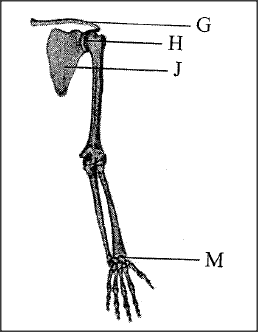

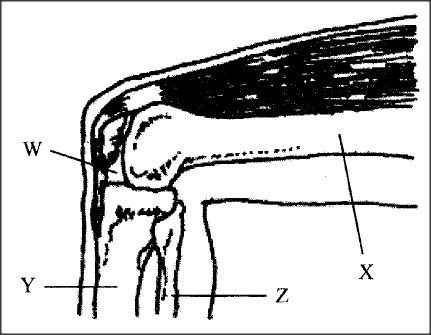
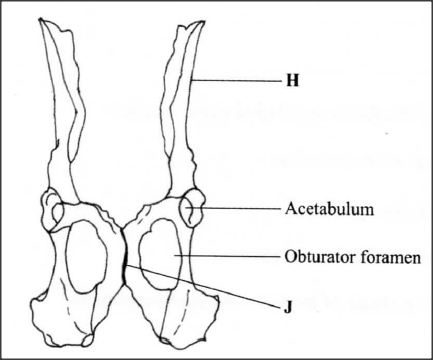
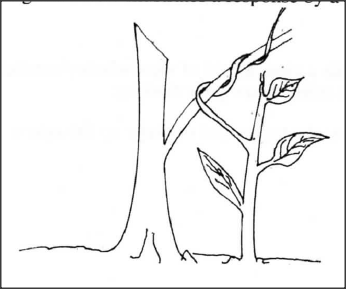
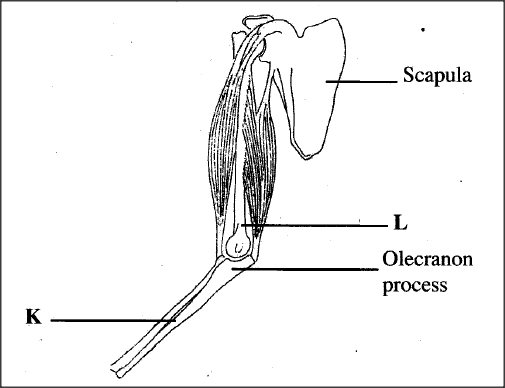

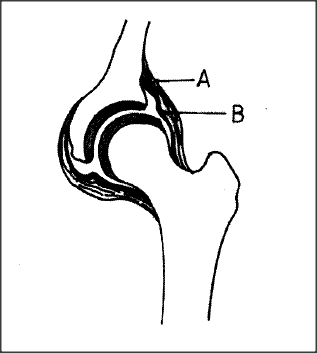







 RSS Feed
RSS Feed